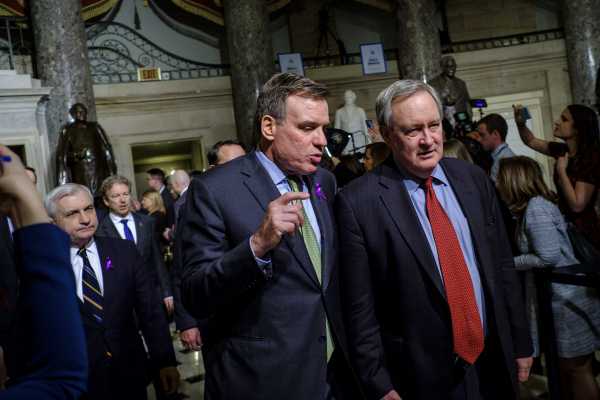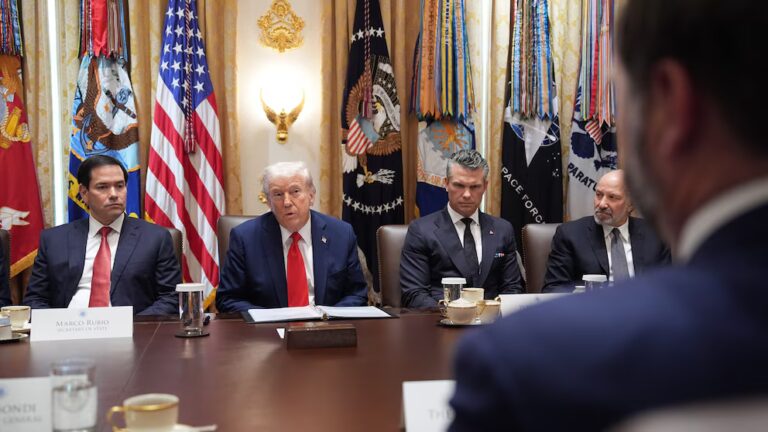
Republicans and Democrats in Congress appear to have finally found something they can agree on, and it’s not immigration, or gun control, or health care. They’re easing some rules for banks.
The Senate this week is slated to take up legislation sponsored by Senate Banking Committee Chair Mike Crapo (R-ID) that would rewrite parts of the 2010 Dodd-Frank Act, the landmark financial regulation overhaul enacted in response to the 2008 financial crisis. The Senate bill would adjust the size at which banks are subject to certain regulatory scrutiny and exempt small banks from some requirements for loans, mortgages, and trading, among other measures.
The Economic Growth, Regulatory Relief, and Consumer Protection Act, S.2115, was passed out of the Senate Banking Committee last year after the panel reached a bipartisan agreement on the legislation. Crapo huddled with Democratic committee members Joe Donnelly (IN), Heidi Heitkamp (ND), Jon Tester (MT), and Mark Warner (VA) to craft legislation that would mark one of the most significant rewrites of financial industry rules in nearly a decade.
Senate Majority Leader Mitch McConnell last week filed a motion to advance the legislation, setting it up for a vote this week.
The bill is likely to pass the Senate — it has the support of Senate Republicans and about a dozen Democrats, enough to clear the 60-vote threshold to avoid a filibuster. The House passed its own banking deregulation bill, an even more severe rollback of Obama-era banking rules. If both houses agree upon and pass a final bill, it would mean that the first major piece of bipartisan legislation to come out of Congress this year would be one to help the banks.
The bill’s proponents say it is an example of bipartisanship at its best. But progressives say it goes too far and that it purports to help small community banks when its changes really benefit large financial institutions.
The bill changes what size banks regulators scrutinize
The Dodd-Frank bill, which was passed in 2010 in response to the financial crisis, aimed to decrease various risks across the financial system and increase regulatory oversight to prevent such a meltdown from happening again. Republicans have wanted to unravel Dodd-Frank essentially since it became law, and President Donald Trump vowed to “do a big number” on it soon after taking office.
At the core of the Crapo bill is the assumption that the Dodd-Frank financial overhaul was overly aggressive and harmed smaller banks in attempting to rein in the larger financial institutions that caused the 2008 financial crisis.
The provision of the bill that has garnered the most attention is one that would raise the threshold at which banks are subject to certain federal oversight, including stress tests that measure a bank’s ability to withstand an economic downturn. Under current law, banks with assets of $50 billion or more are considered systematically important financial institutions (often referred to as SIFIs) and are therefore subject to stricter oversight from the Federal Reserve.
The Senate bill would increase the SIFI threshold to $250 billion. Banks with assets of less than $100 billion would be freed of current oversight requirements, and those between $100 billion and $250 billion would no longer be subject to tougher rules after 18 months, although the Fed could determine periodic stress tests and other tailored oversight measures. That would free up a lot of regional banks from the heightened regulatory scrutiny they face today, including BB&T, SunTrust Banks, Key Bank, and American Express. The bill could affect about two dozen banks in total.
A number of regulators and lawmakers on both sides of the aisle have said that Dodd-Frank’s $50 billion threshold should have been set higher. Former Federal Reserve Gov. Daniel Tarullo, a Democrat, said in his “departing thoughts” in April 2017 that the $50 billion cutoff was “too low.” Even Barney Frank, the former Massachusetts Democratic representative who helped craft Dodd-Frank, has admitted that the $50 billion number was a “mistake.”
But the new $250 billion threshold has raised some eyebrows. In a recent CNBC op-ed, Frank said that were he still in Congress, he would vote against the bill because of the $250 billion mark. (He has suggested a threshold in the $125 billion range.) He pointed out that the failure of two or three such institutions would put us in “Lehman Brothers territory,” referring to the investment bank that filed for bankruptcy in September 2008, precipitating the financial crisis. Countrywide Financial, one of the country’s largest subprime mortgage lenders that was at the center of the 2008 mortgage crisis, had assets in the $210 billion range before it failed.
But the bill’s proponents say it provides targeted regulatory relief and that banks in the $100 billion to $250 billion range won’t be off the hook entirely. They’ll still face periodic stress tests, and the Fed can enact enhanced supervision if it wants.
Federal Reserve Chair Jerome Powell said during his nomination hearing before the Senate Banking Committee in November 2017 that he would continue to have “meaningful” stress tests for banks in that range. In a hearing last week, he said the bill gives the Fed “the tools that we need” to apply enhanced standards to banks in the $100-$250 billion range.
But exactly what those enhanced standards would be, or whether the Fed would actually apply them, is unclear.
Frank also criticized a provision in the bill that he said weakens anti-discrimination standards in housing by raising the number of loans a bank can make before it’s required to report on the issue. Another provision that he singled out allows foreign megabanks, such as Deutsche Bank and HSBC, to put their American assets into a separate holding company to avoid US regulatory scrutiny.
What sort of relief big foreign banks would get from the bill has been up for debate. A fact sheet put together by moderate Democrats backing the bill says such institutions will still be subject to stress-tests requirements. Powell, in a Senate Banking Committee hearing last week, said he doesn’t think the bill would weaken supervision for foreign banks when asked about the matter by Sen. Sherrod Brown (D-OH). But Treasury Secretary Steven Mnuchin in a January hearing told Brown that he believed the Senate bill would lighten foreign bank regulations.
There’s a lot in the bill for community banks and credit unions
Community banks and credit unions are entities that have smaller volumes of business than Wall Street firms and derive most of their funds and lending operations in the local areas where they operate. Those backing the Crapo bill say its main purpose is to relieve community banks and credit unions — generally those with $10 billion or less in assets — from some of Dodd-Frank’s requirements that may be onerous for smaller institutions.
Tarullo, the former Fed governor, said in November that “the fact that community banks are subject at all to some of the Dodd-Frank Act rules seems unnecessary to protect safety and soundness, and quite burdensome on the very limited compliance capabilities of these small banks.”
Paul Merski, who heads congressional relations at the Independent Community Bankers of America, an industry group, told me there is a lot of relief in the mortgage-lending space in the bill specifically. The legislation would deem certain mortgages held by lenders with $10 billion and under “qualified mortgages,” which would allow small banks and credit unions to expand the types of mortgages they offer. It also eases appraisal requirements on certain mortgage loans and exempts small banks from certain
“A lot of community banks that don’t do large volumes but do some mortgage lending have to comply with complex, onerous rules, and many of our community banks have dropped out of the mortgage lending market,” Merski said. “One component is really to make sure there’s competition in the mortgage lending business so that community banks can maintain mortgage lending as part of their business.”
The bill also exempts small banks from the Volcker Rule, which prohibits them from making certain kinds of speculative investments with their customers’ money. And it adjusts leverage ratios — the measure of a bank’s financial sustainability — for such entities.
Proponents of the legislation note that the number of community banks in the United States is dwindling, an important issue for rural communities. Community banks are four times more likely to operate in rural counties than larger institutions, according to a study from the FDIC.
Critics, however, say that exempting small banks from certain requirements is risky and could be harmful to consumers. The progressive Center for American Progress said the bill’s elimination of escrow requirements for banks under $10 billion removes an “essential borrower protection.” It also criticized the qualified mortgage loan change as a dramatic expansion that “gives lenders a major safe harbor for nontraditional underwriting practices reminiscent of those that caused the crisis.”
It is also worth noting that community banks aren’t exactly suffering financially: According to the FDIC, community banks reported increases in net income from the year before in every quarter of 2017.
Beyond asset threshold adjustments and community bank relief, the bill also throws in some marginal consumer protection provisions. It includes free credit freeze and year-long fraud alerts, largely a response to last year’s Equifax data breach, and some new protections for veterans, seniors, and members of the military.
A lot of Democrats don’t love the bill — but it might be the best deal they’re going to get
The politics behind the bill have exposed fault lines within the Democratic Party. Progressives and many 2020 presidential hopefuls in the Senate have lined up against the legislation, while some moderates and those from rural states support it and seek to hold it up as an example of their ability to work in a bipartisan manner.
Sen. Elizabeth Warren (D-MA) in an email to supporters last week, per BuzzFeed, slammed her colleagues over the legislation. “Republicans AND Democrats are gutting the rules on Wall Street,” she declared.
Lobbying groups have upped efforts to influence the bill. “There are many different interests in financial services that are looking at this and saying, ‘Oh my god, there’s finally going to be reform to Dodd-Frank that may move, let me throw in this issue and this issue,” Sen. Chris Coons (D-DE), a co-sponsor of the bill, told the Intercept. “There are a dozen different players who decided this is the last bus out of town.”
The Financial Times pointed out that banks that stand to benefit from the legislation — namely, those with assets within sight of the $50 billion range — appear to have increased donations to Senate Democrats who support the bill. Individuals connected to Signature Bank, a regional bank, have donated $112,000 to senators so far in the 2017-’18 election cycle, eight times as much as it did during the entire 2015-’16 election cycle. Sens. Heitkamp and Donnelly, two of the bill’s co-sponsors, have been the biggest recipients of the Signature-linked Democratic donations.
Ian Katz, an analyst at the Washington research firm Capital Alpha Partners, told me it’s possible the Crapo bill could introduce some risk, as certain banks will now get less supervision, but the scenario won’t be dire. “It doesn’t look to me like it introduces new significant risk into the system,” he said.
And to be sure, the largest entities — JPMorgan Chase, Bank of America, Goldman Sachs — will generally be subject to most of the same regulations they face today if the bill is passed. The Consumer Financial Protection Bureau, one of the key components of the Dodd-Frank bill, will remain intact. Former Rep. Frank in November 2017 wrote that “well over 90 percent” of Dodd-Frank would be unchanged.
Given where many progressives feared banking deregulation would go a year ago, when Trump signed a directive ordering the restructuring of Dodd-Frank, the Crapo bill could have been much worse. As Katz pointed out, “I honestly think that if Democrats broadly were told a year ago that this would be the extent of what Trump had referred to as ‘doing a number’ on Dodd-Frank, they would probably take this deal.”
Sourse: vox.com






